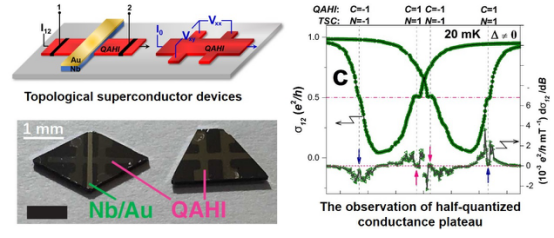In our universe, everything is made up of elementary particles. Some – like photons - are already well-known; others remain to be unveiled. Recently, a group of engineers and scientists has found the “smoking gun” signature of the long sought-after Majorana particle. This research, led by Professor Kang L. Wang at UCLA (also an adjunct professor at SIST), was published in Science on July 21, 2017 in the article “Chiral Majorana fermion modes in a quantum anomalous Hall insulator–superconductor structure.” As one of the corresponding authors, Professor Kou Xufeng, has made major contribution to this work.
Known elementary particles include the fundamental fermions (e.g.,quarks and leptons), which generally are "matter particles" and "antimatter particles", as well as the fundamental bosons (e.g.,photons and Higgs boson), which generally are "force particles" that mediate interactions among fermions. According Paul Dirac’s theory, there is always an associated antiparticle with the same mass and opposite charge to each elementary particle; when they meet, the particle–antiparticle pairs can annihilate each other, hence producing photons (i.e.,energy). Later in 1937, an Italian theoretical physicist Ettore Majorana proposed that there might be one type of fermions: which is its own antiparticle. This unique property of Majorana fermions - carrying zero electrical charge — is viewed as the best candidate to carry a quantum bit, or qubit, the unit of data that would be the foundation of quantum computer. Unfortunately, over the past 80 years, although extensive efforts have been focus on the pursuit of Majorana fermions, their existence remains to be mysterious.
It was only until recently that condensed-matter physicists proposed an alternative approach to design artificial quasi-particles which can mimic Majorana fermions’ behaviors. Specifically, it was predicted that the so-called topological superconducting state (TSC) could be realized in a hybrid system consisting of topological insulators and superconductors, and the collective electrons would behave exactly like Majorana fermions. Following such theoretical work, the team led by Professor Kang L. Wang successfully prepared high-quality magnetic topological insulator-Nb heterostructure devices by using molecular beam epitaxy (MBE). After structural engineering and optimization of the devices, both quantum anomalous Hall (QAH) state and superconducting state were realized simultaneously, which in turn gave rise to the exotic chiral TSC state. Most importantly, by manipulating the external magnetic field (up to ±0.3T), a half-quantized conductance plateau of 0.5e2/h was observed experimentally for the first time, which offered clear evidence for chiral Majorana fermion modes in 1D space.
This experimental breakthrough may help us to unveil Majorana fermions in the future. In addition, this discovery could be the foundation for the realization of robust topological quantum computers given the fact that Majorana particle’s neutral charge property makes it resistant to external interference and gives it the ability to leverage and sustain a robust quantum entanglement which could generate enormous computing power. The researchers said the next step in their research will explore how to use Majorana particles in quantum braiding, which would knit them together to allow information to be stored and processed at super high speeds. Read more at:http://science.sciencemag.org/content/357/6348/294

- About
- News
- Faculty
- Research
-
Academics
- School of Physical Science and Technology (SPST)
- School of Life Science and Technology (SLST)
- School of Information Science and Technology (SIST)
- School of Entrepreneurship and Management (SEM)
- School of Creativity and Art (SCA)
- Institute of Humanities (IH)
- School of Biomedical Engineering (BME)
- Shanghai Institute for Advanced Immunochemical Studies (SIAIS)
- iHuman Institute
- Institute of Mathematical Sciences (IMS)
- Center for Transformative Science (CTS)
- Institute of Carbon Neutrality (ICN)
- Shanghai Clinical Research and Trial Center
- Tech Transfer
- Global
- Campus Life

